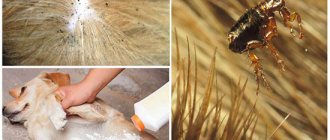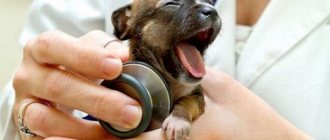What is a lipoma in dogs and what does it look like?
Wen (also known as lipomas) are benign subcutaneous neoplasms that move on palpation. In essence, they are modified and expanded adipose tissue, presented in the form of single or multiple “balls”. The dog does not experience any pain when they appear, and the level of possible discomfort depends more on the location of the lipoma.
Typically, wen forms on the sides, abdomen, neck (at the base of the head), back and chest area, closer to the front legs. Reaching large sizes, they can interfere with walking and create inconvenience when boarding your pet. Ulcers on the surface of small neoplasms appear extremely rarely, but at the same time they can be injured both by the dog itself and by external objects.
Important! Since fat is present not only in the subcutaneous tissue, but also in the internal organs, fatty formations are also isolated on them (usually noticeable in the mesentery). If there is the slightest suspicion of the possibility of benign cells degenerating into malignant ones (fibrosarcoma), it is recommended to remove the nodes surgically.
Surgical intervention is also indicated for the rapid growth of a lipoma, and the larger it becomes, the more difficult it will be to remove it, not to mention the more time for further rehabilitation of the animal. The final decision regarding treatment measures is made by the veterinarian, based on the general condition of the animal and the growth characteristics of the neoplasm itself. Therefore, in any case, it is worth contacting him as quickly as possible, before the wen begins to look even worse.
How can you tell if your dog has a lipoma and not a malignant tumor?
Only a veterinarian can make an accurate diagnosis, but during the first examination, a wen can be distinguished from malignant formations by the following signs:
- a lump appeared directly under the skin;
- if the wen is opened, cloudy discharge from the adipose tissue appears;
- grows slowly or does not change in size;
- neoplasms that are symmetrical in location appear more often;
- there are no other alarming symptoms.
Wen on a dog’s back is not observed so often; the tissue mainly grows on the withers, on the head, in the armpits, on the chest or on the stomach. On palpation you will feel soft tissue, often moving. It is more difficult to determine lipomas located in the intermuscular space, then they cannot be palpated and are difficult to notice visually.
Such formations are visible when their volume is significant, and the size of the organ in which the problem appears increases. You cannot rely only on personal opinion; the animal must be checked; according to statistics, 10% of calls with a similar clinical picture are confirmed by a diagnosis of “wen.”
Why do wen appear in dogs?
The exact origin of wen (as well as other subcutaneous neoplasms) is unknown today, but as for predisposing factors, these include:
- sedentary lifestyle of the animal;
- genetic predisposition to such phenomena;
- disruption of metabolic processes in the body;
- carbohydrate-rich diet and associated excess weight.
Wen often begins to appear in older dogs (after 5 years), and more so in females.
We advise you to read what to do if your dog itches and its hair falls out.
Causes of the disease
It is worth saying right away that in most cases the exact etiology of the appearance of lipoma remains unknown. Even a qualified specialist, without additional diagnostic methods, will not be able to say for what reason the tumor arose. However, there are factors that can provoke this neoplasm to a greater extent, we list them:
- Metabolic disorder. In the animal's body, there is insufficient production of the enzyme responsible for protein.
- Inactivity of the pet. This is especially true for those animals that live in cramped spaces, for example, in a small apartment.
- Age. According to statistics, older individuals who have crossed the threshold of 7-8 years are more likely to suffer from wen.
- Dysfunctions in the functioning of the internal secretion organs (gallbladder and liver).
- Genetic predisposition.
- Gender. According to statistics, wen appears 45% more often in females.
Having dealt with the reasons, let’s move on to the question of what symptoms are characteristic of a lipoma, and how to determine that an animal has a wen.
What are the dangers of wen for a dog’s health?
The most dangerous consequence of the growth of a wen on a dog’s body is its degeneration into a malignant fibrosarcoma, with further spread of metastases throughout the dog’s body. In the absence of timely treatment, the animal dies. Liposarcoma (initially a malignant neoplasm of fat cells) is not such a common occurrence, so it can only be detected with a detailed diagnosis of the existing lump under the skin.
Other unpleasant consequences of the presence of a lipoma include difficulties with the dog’s movement, increased pressure on internal organs and deterioration in their performance, and unpleasant pain, especially when in contact with hard surfaces. With rapid growth, the lipoma enlarges so much that it begins to sag, limiting blood flow in the lipoma itself and causing death in its upper part. This phenomenon is a direct path to pathogenic microorganisms entering the body.
Important! Lipomas with a dark color are considered especially dangerous. This means that the tumor absorbs ultraviolet radiation and is more likely to degenerate into a malignant tumor.
Causes of appearance and breeds at risk
A dog's fatty tumor, or lipoma, is a benign tumor that forms under the skin. It consists of adipose and connective tissue, and looks like a ball-shaped compaction when small in size and blurs when greatly enlarged. Wen can be successfully treated, and in some cases the dog lives with it for a long time without harm to health.
Wen is formed when there is a sharp growth of adipose tissue or clogging of the sebaceous glands. Experts still cannot name clear factors leading to the occurrence of lipomas in pets. Most often they appear in obese dogs or over the age of 5 years; metabolic disorders and hormonal imbalances also contribute to this. For some, the predisposition is inherited. Such benign neoplasms are especially common among Labradors and Golden Retrievers, and American Cocker Spaniels.
Important! Abnormally rapid growth and an increase in the number of lipomas may indicate a dog’s predisposition to other cancers.
How is the diagnosis carried out?
An experienced oncologist is able to diagnose a wen only with one external examination of the animal, with palpation of the formation itself. Usually, a lipoma can be distinguished from a tumor by its softness and comparative mobility, especially if when pressing on the swelling the dog does not show anxiety and does not demonstrate pain in any way. In addition, harmless wen does not change its size for a long time, while harder tumors grow every month.
If a specialist has doubts about the nature of the neoplasm, he may prescribe additional diagnostic tests, the most popular of which will be:
- Carrying out a fine-needle biopsy, in which the contents of the internal part of the neoplasm are transferred to laboratory glass, stained with reagents and examined under a microscope.
- Ultrasound (can examine both the structure of the wen itself, identifying cysts, vessels and other inclusions on it, as well as the abdominal organs to which metastases can spread).
- X-ray as an alternative to ultrasound (allows you to see the shadow of large tumors in the image, in the abdominal and thoracic cavity).
- MRI and CT scans make it possible to determine the presence of tumors and their exact location. These methods are used in case of suspected malignancy of the process.
- A screening study of heart activity and a general blood test are relevant when surgical removal of an existing problem is planned.
If even after removing the wen there are still doubts about its good quality, the extracted material is sent for histological examination. During the procedure, tissue changes are assessed more carefully, although the results of the study have to wait at least 3-4 weeks.
Did you know? Dog-human interaction is especially important in the first 3 months of a small puppy's life. If you do not tame your pet before this time, serious problems will arise with this in the future, and in some cases it will never be able to become a pet.
Treatment
Wen in a dog can only be treated with surgery. The doctor removes the swelling and applies stitches. Removing an actively growing neoplasm is necessary, otherwise problems may arise in the future: after all, it is much easier to remove a small ball under the skin than a large abscess that threatens inflammation.
After removal of the wen, there are practically no relapses, since they do not metastasize. This means that most likely the formation will not appear in the same place again.
Sometimes the drug Ligfol is used as antitumor therapy, as well as after surgery. The instructions for it note that Ligfol improves regeneration processes and has antitumor activity. The drug is sold in glass bottles; injections of the drug Ligfol can be painful.
In this video they tell you what kinds of formations animals have (video author: Mikhail Shelyakov).
Is it possible to remove a wen without surgery?
Removing any formations on the skin or under the skin of an animal is undesirable. It is not difficult to open a wen, but only a professional can apply a high-quality suture without causing infection. Why risk the life of your pet without knowing what exactly the swelling is hiding under the skin? It is better to contact a veterinarian who will take tests and prescribe surgery or treatment.
Treatment of lipoma in dogs
After a detailed examination of the dog and a diagnosis of “wen”, the stage of lipoma treatment begins, possibly even at home. The doctor will explain what exactly needs to be done, but in any case, the success of the animal’s recovery will depend on strict adherence to all the specialist’s instructions.
Removal process using operation
Surgical removal of a malignant or benign tumor is the most common solution to the problem, since it allows you to rid the dog of a “subcutaneous growth” in a relatively short time. The procedure for excision of the wen is carried out under general anesthesia, after having previously examined the animal for problems with the heart and other organs. Age rarely becomes a reason for refusing surgery, but if there are problems with cardiac activity, not all doctors will take responsibility for a favorable outcome of events.
If the lipoma is small, the operation will not take much time, and the recovery of the dog’s body will be faster. With the infiltrating type of wen (affects the deep layers of tissue), everything is a little more complicated, because in the process of surgical intervention it is often necessary to remove not only the neoplasm itself with the capsule, but also part of the muscle tissue.
Postoperative care at home is based on a short course of antibacterial therapy and treatment of sutures, and to prevent the dog from licking itself, it is worth putting a protective collar or blanket on it (depending on the location of the wen).
Important! Self-treatment of a wen with various drugs is unacceptable. Under their influence, a small benign tumor can turn into an aggressive neoplasm requiring radical treatment measures.
Is it possible to do without surgery?
If the pet’s chronic diseases do not allow for classical excision, then you have to think about alternative methods of treating lipoma without surgery. One of these solutions will be radiation therapy performed on a special gamma therapy device. To achieve its maximum effectiveness, the dog is administered sedatives, thereby ensuring a relaxed state and immobility during all actions. After irradiation, the animal is sent to a rehabilitation room, where it comes to its senses next to its owner. In this way, not only benign, but also malignant tumors are treated, although in complex cases it is still impossible to do without surgical excision.
Lipomas do not disappear on their own, but if the animal’s immunity is strong, their growth can stop even at the initial stages of development. You can help your dog’s body cope with this with the help of vitamin and mineral complexes, quality nutrition and regular walks in the fresh air.
Diagnostics
The first thing the veterinarian does is examine the pet. It should exclude abscess, inflammation of the lymph nodes, and hematomas. Next, to determine the nature of the formation, a puncture biopsy is taken, tissue is taken from the deep layers of the lipoma for examination. Histological analysis is carried out.
Another way of research is to remove a small part of the tumor through surgery. They resort to it if the wen has already broken through. Surgical intervention is not started without obtaining data on the benign quality of the formation. If the analysis confirms oncology, then surgery is required, followed by radiation therapy and drug treatment. In this case, it is impossible to give accurate forecasts.
Intermuscular formations are determined only in a hospital setting, using x-rays and ultrasound. If a lipoma appears in a limb, the paw will increase in size and the dog will begin to limp. Sometimes neoplasms form on the intestines, lungs, liver, stomach or uterus, then the disease can be suspected only by the animal’s poor health.
How to care for your dog during recovery
If you consult a veterinarian in a timely manner, the prognosis for treating wen tumors is quite favorable, provided that they do not have time to degenerate into malignant neoplasms. Caring for your dog during treatment and recovery includes the following steps:
- compliance with sanitary and hygienic requirements, with regular cleaning of the surface of the lipoma removal site (the seam is wiped with antiseptic solutions within 10 days from the date of surgery);
- the use of antibiotic injections in the first days after surgery (prevents the development of the inflammatory process and the deterioration of the animal’s well-being);
- prevention of the development of the inflammatory process as a result of scratching, rubbing or licking by the dog of the wen or the area remaining after it (put a blanket or medical collar on the pet);
- if ulcers appear on the surface of the lipoma, they also need to be regularly treated with antiseptics, protecting them from further damage and bleeding;
- During the first time after surgery, avoid active games with the dog, during which it can be injured (this is especially true in cases of tumor formation on the face, paws and abdomen).
For faster recovery and resumption of all functions of the dog’s body, during the entire period of therapy it is worth using only high-quality vitamin and mineral feed mixtures to feed the animal. This can be either ready-made dry products or natural food using boiled vegetables, rice, buckwheat and lean meats.
Did you know? The most developed canine sense is charm. Some animals are able to smell a scent that is 100 hours old, as did the Doberman Pinscher in 1925.
How to treat and what to do?
If the wen does not grow and does not bother the dog, then do not touch it, do not treat it and simply observe it, periodically conducting examinations with a veterinarian, preferably with the specialization of an oncologist or surgeon. You should not pierce or squeeze out a lipoma, this is very difficult and damages the tissue, promotes tumor growth and infection.
Indications for removal
Surgical intervention is required in the following cases:
- the wen interferes with movement and sleep;
- increases in size;
- disfigures the dog;
- compresses internal organs;
During the operation, the surgeon cuts the skin and removes the wen along with the capsule, practically without affecting the surrounding tissue, and separates the blood vessels. When the tumor does not have a capsule, the process of removing it becomes more complicated. The lipoma is fed by small vessels, so you don’t have to worry about bleeding. Postoperative care involves treating the sutures with antiseptics and healing agents for 10 days. The dog is not allowed to lick them; a plastic collar is put on. Small lipomas in calm dogs can be removed under general anesthesia, large formations in large and resistant pets can be removed under general anesthesia.
Sometimes surgery is not possible due to intolerance to anesthesia and other compelling reasons. Then antitumor drugs are prescribed, diet is changed and physical activity is regulated. As your dog loses weight, the wen may decrease in size.
Important! After surgery to remove a lipoma, relapses are rare and some of them are a malignant tumor - liposarcoma. She must be examined by a veterinarian.
Prevention of tumors
Despite the harmlessness of wen, it is better to prevent their occurrence than to look for ways to cope with the problem. The main preventive measures in this case will be:
- compliance with the requirements for the pet’s diet (all food should be rich in vitamins and minerals and not be high in protein);
- regular and long walks with loads that are optimal for a particular dog (it may be enough for small Chihuahuas to run around the house several times, but huskies and other active breeds will need more time to expend accumulated energy);
- monitoring the pet’s weight in order to prevent its obesity (if this does happen, you will have to put the dog on a diet);
- compliance with the vaccination schedule and regular visits to the veterinarian (at least twice a year);
- When using ready-made food mixtures, choose only products suitable for the specific age and breed of the dog, adhering to the manufacturer’s recommended daily dosage.
To exclude the genetic factor in the formation of benign or, especially, malignant tumors, you should be as careful as possible in choosing a breeder. Both parents of the puppy must have all the documents confirming their health and the absence of hereditary problems
Caring for a dog with wen
If a dog is found to have a wen, as mentioned above, you should definitely consult a doctor to prescribe treatment. A pet with this disease does not have any special restrictions. But after removing the growth, it will need simple care: it usually involves treating it with antiseptics. Sometimes injections are prescribed, including Ligfol. You can see what the drug Ligfol looks like in the photo.
Also, after the operation, a special collar is put on the animal, which prevents it from licking the stitches. The postoperative wound heals quite quickly - after ten days you can take the dog to an appointment to have the stitches removed.
Methods for treating wen
Wen (lipoma) is always a benign tumor that rarely causes any inconvenience to the animal.
If this neoplasm:
- small sizes,
- painless,
- has no growth dynamics,
- does not affect the life of the pet,
- has no signs of inflammation,
- does not open on its own,
then it is customary to leave it in the format in which it is. You should not smear the wen with anything, pierce it, apply compresses, etc. – there is always a risk of provoking increased tumor growth and/or its degeneration into cancer.
In all other cases, the lipoma can only be removed surgically. Especially when the lipoma is located in a place that is subject to constant mechanical stress (armpit, for example).
All lipomas are divided into:
- non-infiltrative;
- infiltrative (spilled).
The first group of tumors has a clear, limited contour, making them very easy to remove. The second group is characterized by germination into neighboring tissues and is difficult to remove (since damaged neighboring areas also have to be cut out). Also, it is this group of wen that most often degenerates into an oncological (malignant) form.
It is strictly forbidden to independently open (pierce) any seals on the body of pets, because... a non-specialist will never determine for sure what is hidden under one or another subcutaneous lump, and whether it is a wen and benign!
- Before the operation, the animal must be prepared. For at least 12 hours (ideally 24 hours), animals - be it a cat or a dog - are not fed, but water is given upon request. This contributes to a faster effect of general anesthesia and prevents narcotic vomiting. Local novocaine or ledocaine anesthesia is also used (ledocaine is contraindicated in cats due to individual sensitivity and numerous severe side effects, including death). If the wen ruptures or there are signs of bleeding from it, the operation is performed urgently and without fasting preparation.
- Removal of the wen usually occurs through a small incision. If infiltration (growth into surrounding tissues and muscles) was observed, then the fatty tumor will be removed along with the affected areas. If the tumor is large, a drainage must be formed - a place for the drainage of exudate, which will certainly form in the postoperative period. The postoperative wound will also be washed through the drainage.
- Fatty tumors that are located on the border with the main nerve ganglia or branches deserve special attention - operations in such cases are carried out with extreme caution so as not to catch them and not to disrupt the innervation (the passage of nerve impulses).
- If there are any signs of purulent inflammation of a postoperative wound, you should immediately contact a veterinary clinic for help, and not necessarily the doctor who operated (although this is recommended!). It is also necessary to monitor the wound dressing and comply with all the specialist’s requirements.
- The likelihood of recurrence after surgery is minimal. Exceptions are infiltrated lipomas, which are very difficult to remove completely, so cases of the return of wen with this form of neoplasm are quite possible. If there is a genetic predisposition to the formation of lipomas, they may reappear not only in the place where surgical removal was performed, but also in any other place on the animal’s body.
- Depending on the outcome of the operation, the cat/dog may be prescribed a course of antibiotics, painkillers and sedatives.
- If, after a biopsy, a malignant degeneration of the wen is determined, then chemotherapy is prescribed. Typically, a chemotherapy course consists of the following drugs: prednisone, vincristine, cyclophosphamide and doxorubicin. In 71% of all cases, therapy has a positive effect. Schemes and dosages are calculated strictly by a veterinary specialist, based on this specific situation.
Symptoms of the disease
In general, the symptoms of a lipoma are not very indicative, and not always even an experienced dog breeder will be able to distinguish a lipoma from any other tumor. First of all, you need to pay attention to the appearance of the tumor and its structure. This is not particularly difficult: a soft, gradually increasing swelling appears under the animal’s skin.
If it appears on the stomach or back of the animal, and does not rub against other surfaces of the body, then the skin does not suffer from irritation or redness, and the hair does not fall out at the site of localization. The skin itself on a protruding tumor does not bleed or darken due to an increase in the amount of melanin compared to healthy areas.
A characteristic feature of a wen is the mobility of the tumor; when touched, it seems to “roll”.
Lipoma can appear on
the head
or
neck
of a pet; wen on the eyelid look especially unpleasant, they resemble large warts that prevent your four-legged friend from blinking. The tumor does not in any way affect the animal’s appetite, weight or habits. It will also help to distinguish it from malignant sarcoma by the fact that the lipoma does not enlarge the lymph nodes adjacent to it.
In veterinary practice, single lipomas are more common than multiple ones. But occasionally specialists encounter multiple tumors. This is called lipomatosis. It is characteristic that with it the neoplasms are located symmetrically.
Question answer
How to treat lipoma?
Treatment for lipoma involves removing it. In very rare cases, self-resorption is allowed, but this is one case in a thousand. First, regular tumor measurements and monitoring are prescribed. If during the period established by the veterinarian the wen increases significantly in size, then it is removed surgically.
Does the wen affect the general condition of the animal?
Depending on the location, this neoplasm usually does not affect the overall health of the pet. Exceptions are large abdominal lipomas. They can compress internal organs and disrupt their functions. Also, when lipomas (fat) degenerate, ulceration and bleeding may occur. If large areas are covered, then general signs of intoxication may appear from the absorption of decay products into the bloodstream.
Why is self-medication of a wen (lipoma) contraindicated?
Any disease must be treated by a specialist. The same applies to wen – after all, it is a tumor, albeit benign in most cases. It is prohibited to use any ointments, lotions or compresses. These products can cause skin irritation and inflammation. Attempts to puncture and/or open such tumors will, at best, end in infection; at worst, they will provoke tissue degeneration, and the tumor will turn malignant. If a wen appears on the body of a dog/cat, this is always a strict condition for visiting a veterinary specialist.
If the wen has ruptured (opened)
If the lipoma has burst, you need to urgently take your pet to the veterinary clinic for surgical intervention to remove this tumor. The risk of infection is very high, and when attempting any medicinal intervention, there is a risk of degeneration from a benign state to a malignant one.
Importance of diagnosis
Thus, diagnosis in this case is extremely important. The fact is that a dog’s “wen” may well turn out to be an abscess (but the skin in this area becomes hot), a hematoma, an inflamed lymph node, or a malignant tumor. Practice shows that “bad”, malignant liposarcoma in dogs occurs in approximately 20-30% of cases.
Veterinarians say that about 10% of sudden “swelling” of the skin in dogs is just wen. Veterinarians diagnose lipomas by touch (palpation), using a puncture biopsy, as well as simple surgical excision of a piece of the tumor. It is especially convenient to do this if the dog’s wen has burst. Then, in general, there is nothing special to lose, and urgent surgery is needed. But before surgery, the doctor still needs to find out what exactly he is faced with.
Let's discuss in more detail some of those diagnostic operations that are most often used in practice. Firstly, tests are always carried out. Their results are important for the veterinarian, as they allow them to accurately determine the current physical and physiological condition of the animal, and to exclude or confirm the presence of infection in the body. In the latter case, it will be possible to assume that on your dog’s side there is not a tumor at all, but an ordinary one. However, an increased level of leukocytes may equally well indicate that it is accompanied by enlarged lymph nodes. In general, general tests are not very reliable.











